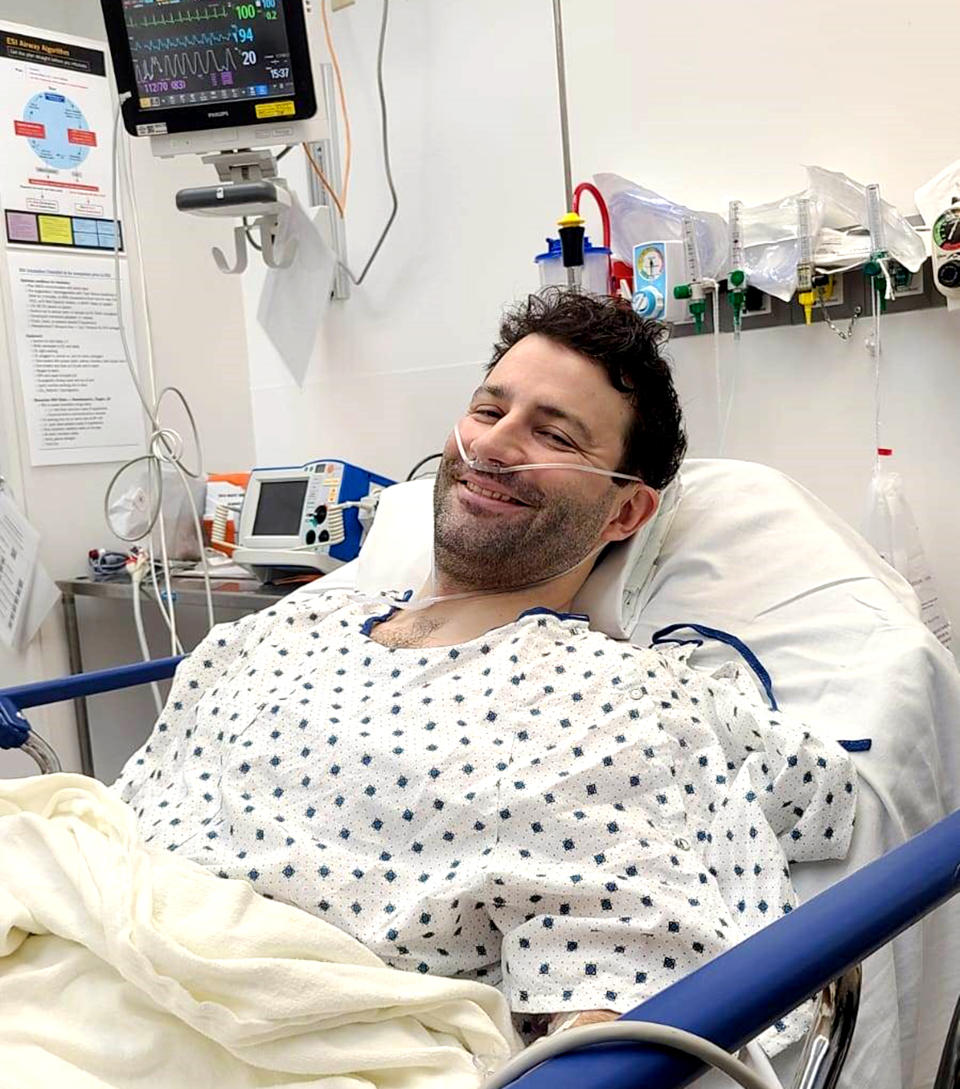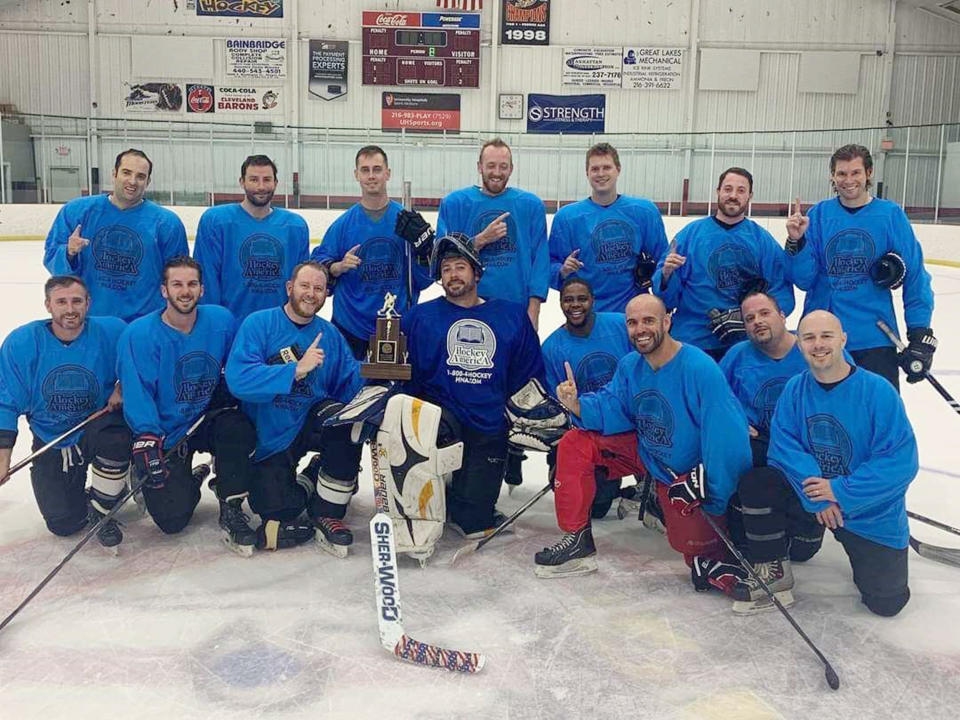Hockey player, 35, shares subtle warning signs he ignored before cardiac arrest
- Oops!Something went wrong.Please try again later.
As Brandon Miller, 35, skated across the ice during the final minutes of his January pick-up hockey game, he stumbled.

“I just thought I was exhausted, and my feet gave out,” Miller, of Cleveland, tells TODAY.com. “The second fall, I couldn’t even get my arms up. It was like I lost all my energy and collapsed, and (I) just remember being very confused.”
Moments later, Miller crashed onto the ice and lost consciousness because he was in cardiac arrest, when the heart suddenly stops beating. Luckily, three of the other players were medical professionals, who immediately began performing CPR and using an automated external defibrillator (AED) to shock his heart back into rhythm, which saved his life.
“I feel very, very, very happy to be here,” he says. “I happened to be around three trained medical professionals, who not only knew what to do, but also knew how to keep a calm composure throughout the whole thing, which I think helped.”
Shoulder pain, trouble breathing
For a few months, Miller experienced some occasional pain in his left shoulder, which he thought was a muscle strain. One day, he was moving something heavy at home when he experienced intense chest pain. It felt as if he were “breathing in fire," he recalls.
“I sat down and relaxed, and the pain didn’t go away. It stuck around for about 45 minutes or so, and it got pretty intense.”
Soon after, he visited his doctor, who ran blood tests. Miller’s cholesterol was a little high, but the doctor didn’t see “any red flags,” Miller says. He also told the doctor in detail how his body felt when the chest pain occurred.
“My esophagus was getting hot, breathing in,” he says. “Whenever I mentioned that to him, he thought it might be acid reflux. … All the symptoms that I was having seemed they could be symptoms for something else.”
When he took the ice on Jan. 13, Miller felt fine for most of the game. But toward the end of play, he experienced a jolt of pain in his shoulder. He assumed it was the muscle and kept playing — there were only about 15 minutes left in the game.
But then he had his first fall, "which I still remember most of it because I was pretty lucid," Miller says.

He got up and tried skating again when he collapsed a second time.
“I remember up to a point of laying on the ice and being confused, and I remember hearing one of them say, ‘Sorry buddy,’” Miller recalls. “That’s when I realized something was going on, and I don’t remember from there.”
Dr. Mike Fellenbaum, a third-year emergency medicine resident at University Hospitals Cleveland, was also playing that day. With only a few minutes left in the game, he watched Miller sink to his knees.
“(It) is really strange," Fellenbaum tells TODAY.com. "He got up and took another two or three strides and then face-planted. At first, we thought he was having a seizure. It looked like a seizure, and he was still breathing. But he was unresponsive entirely.”
Fellembaum was joined by paramedic Matt Urie and Dr. Venkatesh Kambhampati, an emergency medicine physician at the Cleveland Clinic. They turned Miller on his side, and soon after he stopped breathing.
“You could see the life flowed out of him, and the color just left him. At that point, we all had our hands on his pulses, different pulses,” Fellenbaum explains. “I said, ‘Do you feel a pulse?’ and the other teammates said, ‘No,’ and then we just started CPR.”
Another player called 911 while another grabbed the AED. For the next four or five minutes, the three took turns preforming CPR.
“If you’re doing CPR correctly, you tire out fast,” Fellenbaum says. “I don’t think I even lasted a minute. It was the end of a hockey game, and I was knackered. So, I probably did a minute then Matt got on the chest.”
When the AED arrived, it evaluated Miller's heart rhythm and recommended giving him a shock.
“As soon as I delivered the shock, we got his pulse back,” Fellenbaum says. “I’ve never been a bystander of a cardiac arrest.”
Bystander intervention in cardiac arrest can be the difference between life and death, as many people learned after Buffalo Bills player Damar Hamlin collapsed during an NFL game in January and survived thanks to early CPR and AED intervention. Fellenbaum says, as an emergency room doctor, he sees a lot of cardiac patients who don’t survive because they received no bystander intervention.
The Centers for Disease Control and Prevention estimate that 90% of people who experience cardiac arrest outside a hospital die.
“It’s not something people are comfortable doing that aren’t in the medical field,” Fellenbaum says. “I think that’s why a lot of people die outside the hospital.”
Soon after, an ambulance arrived and took Miller to the hospital. Fellenbaum felt grateful he could help.
“It really hit me how lucky Brandon was that we were there and how lucky we were to have been able to help him,” he says. “I’m used to resuscitating half dead people in the emergency department, and we get a lot of people back. But the truth is most people die because they haven’t gotten CPR.”

Surgery and recovery
While doctors originally considered placing a stent to open Miller’s artery, which was 90% blocked, they worried the stents would need to be replaced in several years. (A stent is a tube used to hold open weakened passages in the body.)
Instead, Miller underwent an open heart, coronary artery bypass surgery at the Cleveland Clinic. “(My doctor) wanted to make sure that (my) surgery ... could last me a lifetime, which ended up working out,” he says.
Miller needed six weeks for the bone to heal where they cut it for the surgery. He can now drive and has begun cardiac rehabilitation.
During the six weeks after surgery, he built up his stamina and was walking two or three miles a day. He hopes to play in a charity hockey game in April, but his doctor isn’t sure if he’ll be recovered enough. He hopes that other young people who hear his story will be more proactive with their health.
“If I had heard a story ... with someone my age (whose cardiac arrest) came out of nowhere, I would have been more hard-headed as far as ... getting stuff checked out (by the doctor),” he says. “If there’s chest pain, go get it checked out. Don’t underplay what’s happening.”
This article was originally published on TODAY.com

